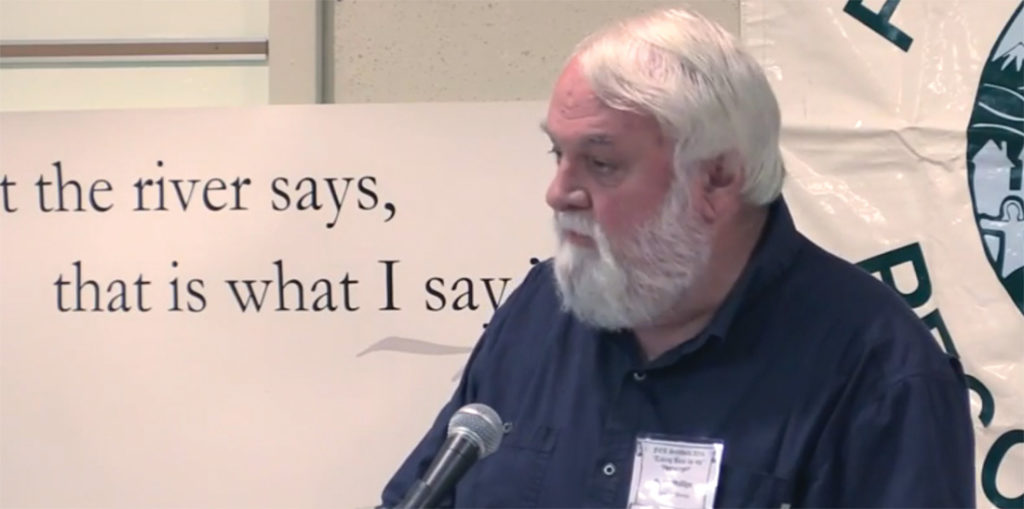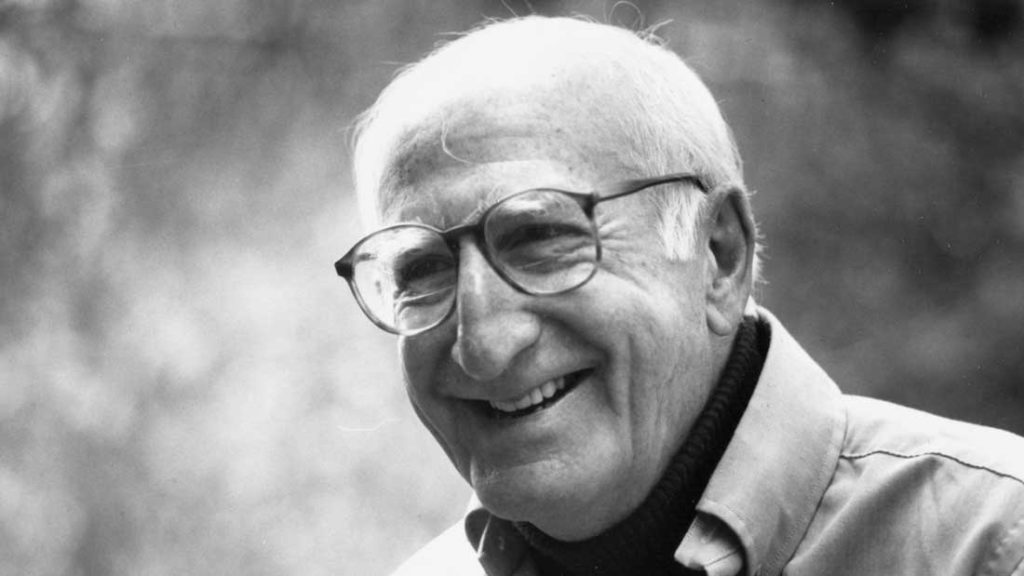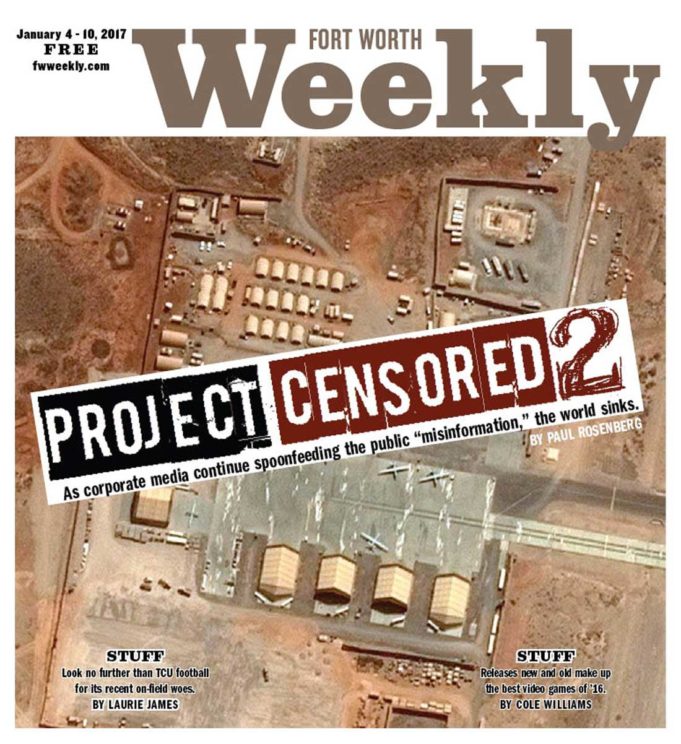Twenty years ago, the founder of Project Censored, a news media research project, looked back on its first 20 years.
“The primary purpose of Project Censored is to explore and publicize the extent of news censorship in our society by locating stories about significant issues of which the public should be aware but is not, for a variety of reasons,” wrote Carl Jensen in the preface to 1997’s 20 Years of Censored News. “The essential issue raised by the Project is the failure of the mass media to provide people with all the information they need to make informed decisions concerning their own lives. Only an informed electorate can achieve a just and fair society. The public has a right to know about issues that affect it, and the press has a responsibility to keep the public well-informed about those issues.”

For 40 years now, Project Censored has been guided by a conception of free speech and censorship based on a civic responsibility, rather than an individual one, and from the perspective of the audience, rather than the speaker. A free press exists for the sake of the community and the country it abides in. A free press exists not just to tell the community what it may want to hear but sometimes what is most painful and difficult — but necessary — to face, whether it’s shameful legacies like racism or threats to human survival like nuclear weapons or global warming.
The unofficial, informal modes of censorship that stifle a free press result in a society whose vitality and capacity to respond to challenges — as well as opportunities — is increasingly undermined. It ultimately sows seeds of social self-destruction. This is why Project Censored’s more expansive concept of censorship — far from being vague or blurry — has a deeply realistic foundation.
This realism is reinforced by how stories have emerged over time. In his 20-year retrospective, Jensen tallied the subject matter of all 200 stories in the annual Top 10 to that point. The top category easily was political with 32 percent, followed by corporate at 18.5 percent, international at 15 percent, military at 14 percent, environmental at 7.5 percent, media at 3.5 percent, economic at 2.5 percent and education at 0.5 percent.
Political, international, and military stories were more common during the Reagan and Bush administrations, while corporate and environmental stories predominated during the Carter and Clinton administrations, Jensen noted.
“However,” he went on, “the most disturbing result of this analysis is the number of issues that still have not been addressed by the major media since Project Censored first raised them.”
More than three-quarters of issues covered by Project Censored could still be classified as “overlooked or censored by the mainstream media,” he wrote, while just 46 stories had gained significant treatment.
Since the Clinton administration of the 1990s, new broad topics have emerged within old categories.
The war on terror is richly represented in annual No. 1 censored stories, such as “The Neoconservative Plan for Global Dominance (in 2004)” and “No Habeas Corpus for ‘Any Person’ ” in 2008 during the George W. Bush administration; and “Over One Million Iraqi Deaths Caused by U.S. Occupation” (2009), “More U.S. Soldiers Committed Suicide than Died in Combat” (2011), “Signs of an Emerging Police State” (2012), and “Bradley Manning and the Failure of Corporate Media” (2013) during Barack Obama’s time in office. The fact that the stories changed so little despite a dramatic “change election” reflects both on our troubled politics as well as our failing media.
A similar criticism applies to global warming, economic inequality, and digital media concerns, from net neutrality to surveillance, as well as enduring problems of racial inequality. What has made the most difference in all these areas has been the emergence of new social movements. These movements have been empowered via social media. They’ve drawn on alternative media to move matters forward despite continued political resistance and media neglect.
The most recent democratization of media from below — first via the internet, then social media — sends far more hopeful signals than the continued failure of the corporate media. In this changing environment, Project Censored’s role in promoting and educating people in critical media literacy yields more benefits for an increasingly large number of engaged participants.
Some sense of that role over time can be gleaned from Project Censored’s own review of past No. 1 censored stories, six that received the most votes from their panel of judges, though two other, closely related stories were included as well:
1.) Censored 1977: The Myth of Black Progress
At the time, the black-white income gap was widening, with white wages increasing twice as fast. Ninety-seven percent of all professional jobs were still held by whites — unchanged since 1969 — and young blacks (especially in urban areas) were already disproportionately affected by policing and incarceration. In New York City, the arrest rate for black youths younger than 16 was almost 10 times higher than in 1950.
 Today, far more whites than blacks think real progress has been made in getting rid of racial discrimination. At least there’s some growing awareness of the deadly dysfunctional criminal justice system, thanks primarily to the Black Lives Matter movement. But the deep systemic nature of the larger problem of a two-tiered nation, and how to transform it — articulated this summer in the Movement for Black Lives Platform — still is rarely mentioned, and much less discussed, in the corporate media.
Today, far more whites than blacks think real progress has been made in getting rid of racial discrimination. At least there’s some growing awareness of the deadly dysfunctional criminal justice system, thanks primarily to the Black Lives Matter movement. But the deep systemic nature of the larger problem of a two-tiered nation, and how to transform it — articulated this summer in the Movement for Black Lives Platform — still is rarely mentioned, and much less discussed, in the corporate media.
2.) The Corporate Crimes of the Century
The original, in 1979, by Mother Jones, covered a broad range of ways in which American companies profit from “dumping” — exporting and selling products abroad that are restricted or banned from use in the United States. This takes advantage of more lax foreign laws. This includes the export of dangerous chemicals, toxic pesticides, even defective medical devices and drugs that are banned, stale-dated, and/or unapproved.
 The second story, from 2000, concerned multinational profits from overseas investments and collaborations with countries that violate human rights. This enables repressive governments to suppress political dissent and violate individual rights, even as corporations claim that their “constructive engagement” improves human rights. This model was conclusively disproved in apartheid South Africa, which has nonetheless been replicated in India, Burma, and Turkmenistan, among many others.
The second story, from 2000, concerned multinational profits from overseas investments and collaborations with countries that violate human rights. This enables repressive governments to suppress political dissent and violate individual rights, even as corporations claim that their “constructive engagement” improves human rights. This model was conclusively disproved in apartheid South Africa, which has nonetheless been replicated in India, Burma, and Turkmenistan, among many others.
While there has been some light shed on specific violations in the mass media, the systemic nature of these problems remains largely submerged. “Corporate media have failed to cover the continuing role of multinational corporations in supporting human rights abuses,” Project Censored notes.
There’s also an increasing problem with new digital technologies as governments and tech companies cooperate in designing infrastructure to censor, surveil, and control citizens.
3.) Wealth Inequality
In 2005, “Wealth Inequality in 21st Century Threatens Economy and Democracy” placed widening U.S. wealth inequality since the 1970s — aided by deregulation in finance and elsewhere and proliferating tax loopholes — into a broader global context. “A series of reports released in 2003 by the United Nations and other global economy analysis groups warn that further increases in the imbalance in wealth throughout the world will have catastrophic effects if left unchecked,” particularly with the rapid growth of urban slums, Project Censored reported.

The top story of 2015 was “Half of Global Wealth Owned by the 1 Percent,” a report from Oxfam International, emphasizing evidence “that extreme inequality is not inevitable but is, in fact, the result of political choices and economic policies.” The report outlined a 9-point plan for fighting poverty and inequality. Corporate coverage of the Oxfam report tended to be brief, broadcast at odd hours or critical of the report’s motives.
The corporate media’s belated coverage of inequality remains superficial, even as expert knowledge and insight has exploded rapidly. The briefly noted Panama Papers data leak on April 3, 2016, was a case in point.
It involved only a single bank, “only one example of how many wealthy people use offshore tax havens in order to reduce, or completely avoid, income taxes,” Project Censored noted before going on to cite Gabriel Zucman’s 2015 book, The Hidden Wealth of Nations: The Scourge of Tax Havens, in which he wrote that “U.S. citizens have at least $1.2 trillion stashed offshore, costing $200 billion a year worldwide in lost tax revenue, from wealthy individuals.”
4.) Censored 1987: The Information Monopoly
At first, people thought media expert Ben Bagdikian was far too cynical and pessimistic. Now, some think he was naïve.
In 1982, his first edition of The Media Monopoly talked about how 50 corporations controlled at least half of the media business.
In the 1986 second edition, it had shrunk to 29, and by the 1990s it would be just six. It’s no surprise that an increasingly monopolized corporate media doesn’t report on how little choice folks have to listen to them.

controlled.
Project Censored’s update notes that “Bagdikian was vindicated when he stated that only six conglomerates would control 90 percent of what we read, watch, and listen to.”
CBS, Comcast, Disney, News Corp, Time Warner, and Viacom own a thicket of print, cable, broadcast, online, and book outlets.
“These companies provide the majority of Americans with their sole source of entertainment and information, though the latter may often be better described as either misinformation or disinformation,” said Project Censored editors Mickey Huff and Andy Lee Roth.
Ending net neutrality could make matters even worse. That “would allow two major conglomerates, Comcast and Time Warner, as well as other big companies such as Cox, AT&T, and Verizon, to essentially construct a two-tiered internet through the creation of monopolies.”
5.) Censored 2008: No Habeas Corpus for “Any Person.”
Habeas corpus — the right to challenge governmental power of arrest and detention — is the oldest human right defined in English-speaking civilization. It dates back to the signing of the Magna Carta in 1215. Yet it was effectively undercut by the Military Commissions Act (MCA) in 2006, which essentially did away with habeas corpus rights for “any person” arbitrarily deemed to be an “enemy of the state,” as identified by the president.
Project Censored noted that the “corporate media, including a lead editorial in the New York Times on Oct. 19, 2006, gave false comfort that we, as American citizens, would not be the victims of the draconian measures legalized by this act.”
Independent journalist Robert Parry pointed to a text in the MCA that allowed for its application to “any person” regardless of American citizenship.
In an encouraging update, Project Censored noted that the Supreme Court found Section 7 of the MCA unconstitutional, thus allowing detainees to challenge their detentions, partially restoring the right of habeas corpus. The following New York Times coverage was “a more honest and valid representation of the issue than the coverage from 2006.”
But coverage is still spotty and the right has not been fully restored.
6.) Censored 2015: Ocean Acidification Increasing at Unprecedented Rate
“Global warming” has always been shorthand for a complex process that is destabilizing the global ecosystem in multiple interacting ways. It is driven by the increase in atmospheric carbon. A quarter of this carbon is being absorbed by the oceans.
 On the one hand, this absorption has slowed global warming, on the other, as Craig Welch reported for the Seattle Times, it’s driving a dangerous process of acidification, which is “helping push the seas toward a great unraveling that threatens to scramble marine life on a scale almost too big to fathom and far faster than first expected.”
On the one hand, this absorption has slowed global warming, on the other, as Craig Welch reported for the Seattle Times, it’s driving a dangerous process of acidification, which is “helping push the seas toward a great unraveling that threatens to scramble marine life on a scale almost too big to fathom and far faster than first expected.”
It both erodes some animals’ shells and skeletons and leaches important nutrients from the water. Impacts are greatest in the Arctic and Antarctic, because cold, deep seas absorb the most carbon dioxide. But the average acidity of surface ocean waters worldwide is more than 30 percent greater than it was at the start of the Industrial Revolution.
Despite the magnitude of the problem, there is little funding for research on it and very little media attention as well.
Little has changed in the past year, despite some attention to coral bleaching, one of the most dramatic examples of the impact of acidification. The deeper issues and long-term consequences remain obscured.
As the above stories illustrate, specific censored stories are not isolated islands. Rather, they are the higher peaks of entire submerged ranges of inter-related issues. And while the most obvious and easily grasped purpose of Project Censored has been to bring specific censored stories to light, its ultimate goal is to empower us all to lift up entire hidden continents of urgent public concern. This way, they can be scrutinized and discussed on how to deal with them in the full light of day, just as America’s founders hoped that we might.
Paul H. Rosenberg is senior editor at Random Lengths News, an alternative biweekly newspaper in the Los Angeles Harbor Area. He is also a regular contributor to Salon.com.












